By Simon Dewulf
Abstract
This paper provides a structured approach to researching outside a particular domain. Product DNA™ forms a common ground for technology transfer, be it in new product development, problem solving or new market development. The paper shows the simplicity of the method, while its increased functionality in relation to other structured approaches.
Keywords
Properties, TRIZ, Product DNA, problem solving, solution marketing
Introduction: Innovation by Transfer
In January 2004 Fiji launched "Shade of Darkness," a customized bronzing system. The system allows users to design their own depth of darkness. In 2005 Oli-Ola oil/vinegar mixer was awarded best packaging 2005 in New York. In May 2006 Dave's Gourmet brought its adjustable heat sauce to market.
| Figure 1: Same Principle, Different Products |
| 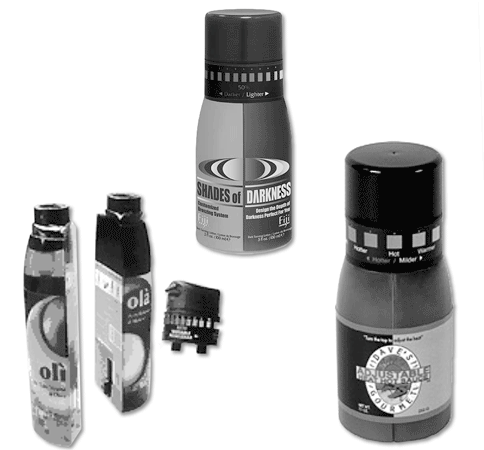 |
|
|
The basic principle is the same for all three products – a dosing system (comprising two containers) and a dispensing unit. Yet the application domain moved from cosmetics to food over the years. The same packing system can give rise to other customizable solutions in different areas – the property is "dual," the function is "dosed mixing." This transfer is direct as both the property and the function are identical – only the domain varies. To make a systematic approach from this observed successful transfer, a larger pool of innovations needs to be considered.
Product DNA™: Order Property-function
Consider the group of products shown in Figure 2 – at first glance, little communality is seen. The matrix structure, however, expresses a vertical communality of properties. Of course all systems have a large set of properties; here only the property that is enabling one of the main functions is considered. This is the first proposed classification, only based on one property.
| Figure 2: Property-function Relations in Pool of Products |
| 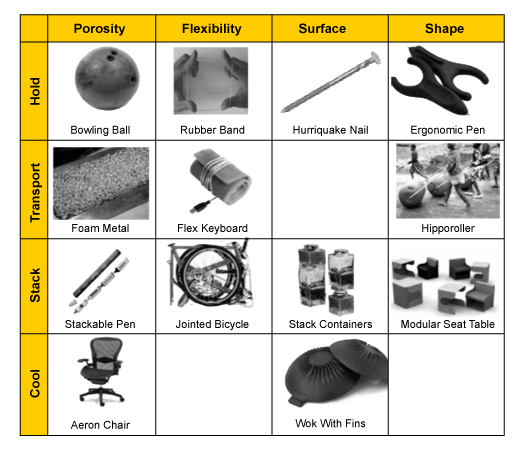 |
|
|
The main function that is allowed by the property classified is displayed horizontally. For example, the bowling ball is held (function hold) by the holes (property porosity). This brings a classification to all products, whereby the link between the properties and the functions are expressed. The concept of "Product DNA" is the sum of the properties and the functions that are present in a system. The nature of evolving Product DNA is where systems change their properties, to bring new functions. Figure 3 shows the evolution of a beer glass. Every change of property brings a new function. Geometry allows stabilizing, holding and insulating; porosity also allows insulation. One property allows different functions and one function can be achieved by different properties.
| Figure 3: Product DNA™ Property-function Matrix |
| 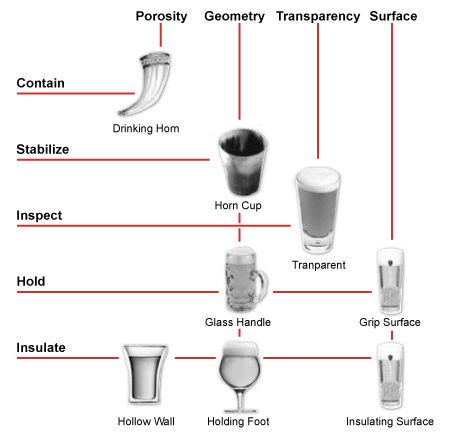 |
|
|
The Product DNA™ Property-function Matrix
By classifying a large amount of systems in that way, a matrix of property-function relationships can be constructed. In that matrix, a cell will defend a relationship. Figure 4 shows products that perform the function "hold" with the property "surface."
| Figure 4: Excerpt of Property-function Matrix |
| 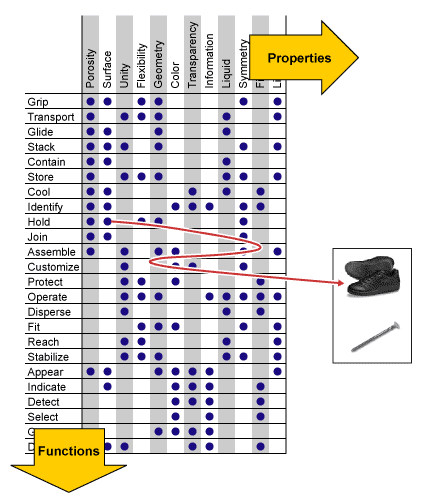 |
|
|
Figure 4 is a generic table based on systems across domains. It is a base for knowledge transfer. Since properties and functions are identifiable in any domain, however, a specific matrix can be built and compared to the generic matrix.
| Figure 5: Property-function Matrix Built From Chocolate Patents |
| 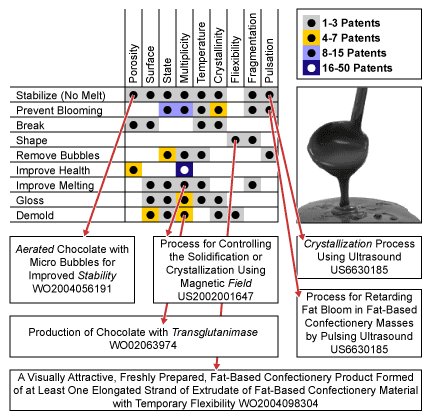 |
|
|
Figure 5 shows a property-function matrix built from chocolate patents. Every patent claims that with a certain property (e.g., aerated chocolate) a function has been improved or created (e.g., stability). Look to related domains and find a difference, i.e., where have similar functions been achieved with different properties?
Example: Cake Boxes
While looking at innovation in the domain of cake boxes, a list of functions can be identified: resistance to crushing, preventing horizontal movement or removing the cake. Again a matrix of functions and properties can classify the results. Looking at the Product DNA™ of cake boxes, familiarity can be identified in egg boxes, burger boxes or pizza boxes. The difference in solutions can bring new specifications. Consider the function "prevent horizontal movement" – cake patents have described a surface structure that provide grip and, hence, prevent horizontal movement. Pizza box patents have described an integration of a pin, so to "pin" the pizza in the middle. Can this idea be transferred to cake boxes?
Example: Liquid Sugar
Product DNA™ can also relate areas by analogy and identify what area has already solved your problem. Take the problem solving of clear liquid sugar shown in Figure 6 shows the domains in which that problem occurs. This graphically represents the "where" in "somewhere." The less related domains provide the bigger potential of different solutions. Since Product DNA™ defines the set of properties and functions in abstract, the abstract search can bring forward new application domains.
| Figure 6: Product DNA™-related Domains for Liquid Sugar |
| 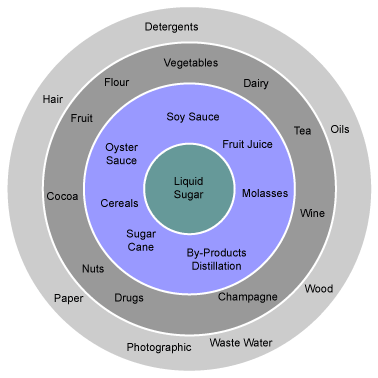 |
|
|
A Base for Technology Transfer
Product DNA™ can be visualized as a set of properties and functions, where both are variables. A property is interpreted as a turning knob or slider of which the variations can enable new or improved functions.
| Figure 7: Graphical Representation of Product DNA™ |
| 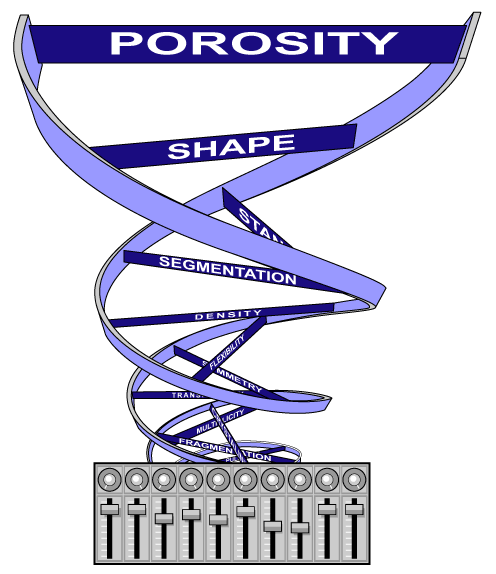 |
|
|
The property-function matrix can be constructed as a tool to compare players in a specific field – the field is defined by a list of required functions and their solutions (property variation) to these functions. Figure 8 shows an example outcome of a domain, in which the size of the points show the number of patents and the shades indicate the different players. It is a snapshot of 2007; evolution over time, with the dots gradually growing, can show the activity of the players over the years.
| Figure 8: Patent Survey of Specific Domain |
| 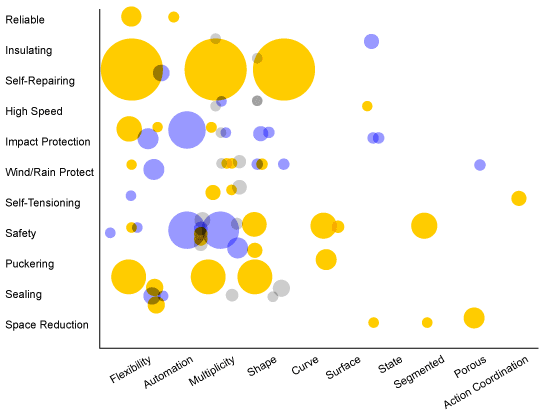 |
|
|
Product DNA™ for Solution Marketing
Often the required innovation is not a problem that needs a solution, but rather a solution that needs problems. Solutions in search of problems can be specially designed materials, for which new applications are sought. Often waste streams are studied for application; a rise in patents where waste turns into functional products has been observed in recent years. Here again a property-function matrix forms an ideal platform for identifying new markets.
| Figure 9: Product DNA™ String for Solution Marketing |
| 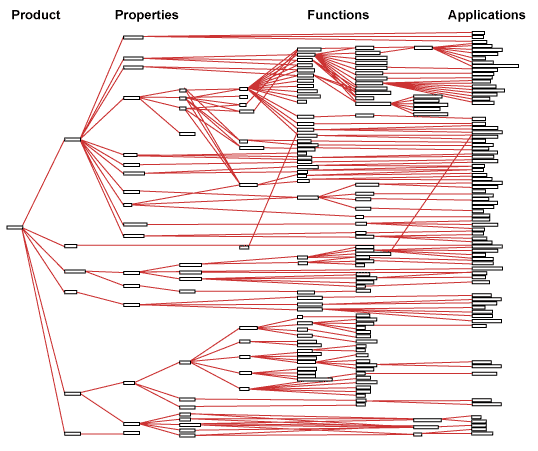 |
|
|
Figure 8 shows a string structure in which a set of properties is linked to a set of functions that give rise to a list of possible applications. The questions answered here are: who needs these properties and who else needs their connected functions? Often this method (solution marketing) is applied to process applications. Again an industry can own a technology or machine park to make a set of products. What else can that process make?Conclusion
If systematic approaches to innovation are pushing the view outside the domain, a form of filtering or direction is needed. Product DNA™ provides a structure, a common ground, a checklist for knowledge transfer.
This can be applied to new product or process development. Related Product DNA™ provides analogical properties or functions. The difference in these products brings interchangeable new specification. Take a glass, a window and glasses. They share brittleness, transparency, hardness and other material properties. Yet windows are double-glazed and glasses zoom in. Seeing differences as new specifications can create a double-glazed drinking glass or a window that zooms in. Product DNA™ provides a 360 degrees checklist for new development opportunities.
References
- Dewulf, Simon, Directed Variation, Solving Conflicts in TRIZ – Part 1, The TRIZ Journal, September 2005.
- Dewulf, Simon, Directed Variation, Solving Conflicts in TRIZ – Part 2, The TRIZ Journal, October 2005.
- Dewulf, Simon, Directed Variation, Solving Conflicts in TRIZ – Part 3, The TRIZ Journal, November 2005.
- Dewulf, Simon, Directed Variation® Talent of the Product, The TRIZ Journal, December 2005.
- Dewulf, Simon, Lahousse, B., Theeten, V., Directed Variation® Piston Ring Case, The TRIZ Journal, January 2006.
- Dewulf, Simon, Variation of Properties for New or Improved Function, Keynote Address at 3rd TRIZ Symposium, Yokohama, Japan, 2007.
- CREAX, Directed Variation® DIVA innovation suite, released September 2006.
- More Inspiration website, http://www.moreinspiration.com.
- CREAX company website, http://www.creax.com.
Note: Previously published at the European TRIZ Association-TRIZ Futures 2007, Frankfurt Germany, November 6-8, 2007.
About the Author:
Since January 2000, Simon Dewulf has been the Managing Director of CREAX N.V., a Belgian-based innovation research, training and service center. He lectures at several universities and research institutes across Europe on the topic of innovation. Contact Simon Dewulf at simon.dewulf (at) creax.com or visit http://www.creax.com.
Copyright © 2006-2011
– RealInnovation.com, CTQ Media. All Rights Reserved
Reproduction Without Permission Is Strictly Prohibited –
Request Permission
Publish an Article: Do you have a innovation
tip, learning or case study?
Share it
with the largest community of Innovation
professionals, and be recognized by your peers.
It's a
great way to promote your expertise and/or build your resume.
Read more about submitting an article.